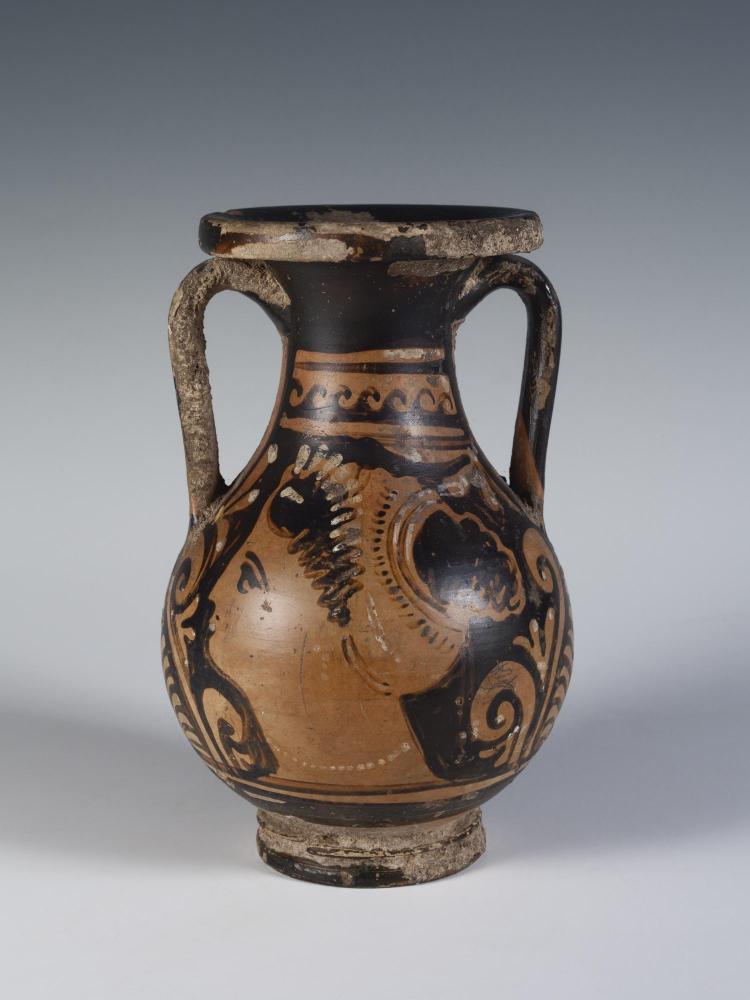2006.15.T, Apulian Pelike
Catalogue Entry 

This vase is one of a collection of Greek vases held by the CU Art Museum.
Gift to CU Classics Department
Transferred to CU Museum of Natural History
Transferred to CU Art Museum (2006)
Height: 18.1 cm
Diameter (max.): 11.4 cm
Date: 375 - 325 B.C.E.
Origin: Apulia (South Italy)
Description: Painted ceramic pelike with characteristic sagging belly and one handle on each side. On each side of the vase between the handles is the profile of a woman's head, facing left, in reserved color of clay against black slip background. Added white on each side indicates a necklace, earring, and ornamentation on the hair. Above the woman's head on each side is a sea wave pattern and beneath each handle are palmettes. The top of the neck, rim, and foot are black.
Additional photos of this vessel show details of the rim, handles, base, and decorative elements.
Discussion
A pelike is a vessel with a sagging belly used for holding liquids. This particular pelike dates to the mid-4th century B.C.E., a time when this particular shape experienced great popularity in South Italy and Sicily and became a staple in the the South Italian pottery workshops in Apulia and Campania. Originally interpreted as a Greek import, this vase has been re-identified as the work of an Apulian artist.
Each side of this pelike bears an image of a heavily adorned woman's head in profile. Painted in the red-figure technique of vase painting, the light brown clay contrasts with the gray-black slip, bringing each of the profile heads into focus. The top of the vase is decorated with a band of stylized sea waves, a common decoration on South Italian vases. The main decorative panels are complemented by a black rim, neck, and handles.

A single woman's head in profile covers each side of the vase; the two heads are virtually mirror images of each other. The women are elaborately adorned, with added white to indicate a pearl necklace, earrings, and ornamentation to the hair. The portrayal of female heads was quite popular in South Italian vase painting at this time, especially on smaller vessels such as pelikai. Women were often depicted in the process of ornamenting themselves or in preparation for a wedding ceremony. Such women were usually depicted with a variety of jewelry, including necklaces, bracelets, earrings, and anklets, with hair tied up in a knot or bun and/or adorned with a tiara-like crown. It is difficult to know how to interpret this and similar vases, but the artist likely intended this to represent an elite woman.
Pelikai were containers for liquid, whether in storage or dining. They could be constructed in various sizes and may, perhaps, be a smaller variation of the one-piece amphora. Unlike the the neck-amphora, which often had a sharp transition between the neck and the body, pelikai had a sinuous curving neck that smoothly transitioned into the vessel's body. The sagging shape of the pelike's belly has led many scholars to conclude that it was primarily used to store and transport wine and oil.
A kantharos at the Cleveland Museum of Art, dated to c. 330-320 B.C.E., resembles this pelike's decorative scheme. On each side of the Cleveland kantharos is a female head in profile. White paint was added to indicate the necklace, earrings, and ornamentation to the hair. In addition, the characteristic sea wave pattern decorates the exterior of the cup's rim.
References
- John Boardman, Athenian Red-Figure Vases: the Classical Period (London: Thames & Hudson, 1989): 239-240.
- A.D. Trendall, Red Figure Vases of South Italy and Sicily, A Handbook (London: Thames and Hudson, 1989): 7-25.
- A.D. Trendall, "Farce and Tragedy in South Italian Vase-Painting" in eds. Tom Rasmussen and Nigel Spivey, Looking at Greek Vases (Cambridge: Cambridge University Press, 1991): 151-182.
- Chara Tzavella-Evjen, Greek and Roman Vases and Statuettes from the University of Colorado Collection (Athens: Archaiologikon Deltion, 1973): 192-197.

